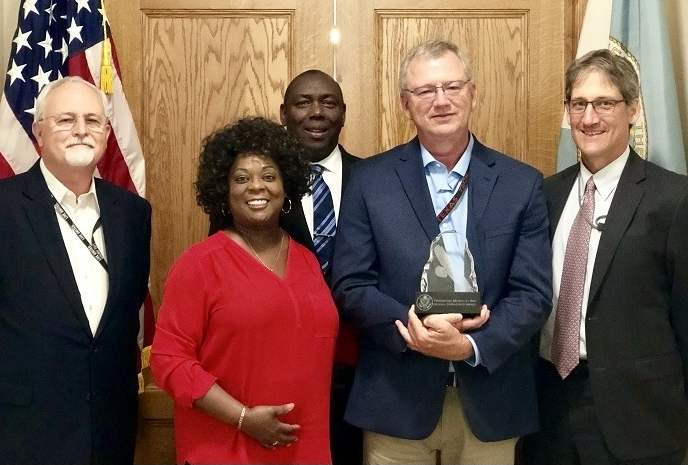Pantex Blog
POLO presents at WT Engineering Camp
Pantexans with POLO recently took part in the annual Engineering Camp held each summer at West Texas A&M University in Canyon.
Milton Guerrero with Pantex Nuclear Procurement Engineering was a guest speaker at the event and spoke on the world of engineering and led students in an activity to help demonstrate how the world of engineering works.
Lance Duncan from Pantex Mission Engineering also presented at the event which was geared towards high school students.
During the presentations students learned about Pantex and Y-12, the different types of engineering (Mechanical, Environmental, Electrical, etc.), salary statistics, and the backgrounds of the guest speakers.
“This event was important to me because it was an opportunity to inspire kids to follow the path to becoming an engineer,” Guerrero said. “I attended this event to not only inspire but to also give back to my alma mater WTAMU.”
Recruiting for tomorrow’s workforce
Students at several colleges recently had the opportunity to attend a Nuclear Security Enterprise Day to learn more about jobs available to them in an industry often cloaked in secrecy. During March and April, CNS, along with our colleagues from across the NSE, visited Georgia Tech, Purdue, Texas A&M, and the University of California at Merced to communicate the importance of our national security mission and the opportunities we have available for upcoming graduates.
 Alexi McCallick of Tooling and Tester Design at Pantex (left) talks with a student at the Texas A&M Nuclear Security Enterprise Day |
Human Resources’ Amy Moran, instrumental in recruiting and attracting top talent to CNS, noted, “In the workforce market, there is a war for talent because of our strong global economic environment. Within the NSE, we have the ‘Nuclear Security Enterprise Workforce Recruitment Strategy’ to raise awareness with universities throughout the country of what we do, the NSE mission, and our job openings.”
NSE Days include presentations, panels, and recruiting booths, allowing members of the NSE (including CNS’s Pantex and Y-12) to establish relationships with the universities. “We’re working to develop pipelines for hard-to-fill positions such as cybersecurity and engineering,” Moran said. “Pantex and Y-12 are integral to the NSE’s missions, so it’s important for us to help the enterprise attract a capable workforce to sustain our future nuclear security missions across all sites.”
Charles Herrell of Cyber Operations joined the Purdue NSE Day and thinks these events help potential employers and employees understand one another.
“I enjoyed speaking to the prospective employees for cyber security-related positions. We spoke the same language and shared a passion for protecting cyber assets,” he said. “I have been to recruiting events talking to recruiters about job openings, and they didn’t know the details of what those in my profession do, so it made me left feeling like I could not sell myself because I could see the recruiter’s eyes glaze over quickly.”
2019 Presidential Migratory Bird Stewardship Award Winner
The Council for the Conservation of Migratory Birds is pleased to announce the winner of the 2019 Presidential Migratory Bird Federal Stewardship Award. The U. S. Department of Energy/National Nuclear Security Administration (DOE/NNSA) Pantex Plant was honored at this year’s Council meeting for their innovative work with Swainson’s Hawks, Purple Martins, and other birds across the Western Hemisphere. The Presidential Migratory Bird Federal Stewardship Award annually recognizes a single project or action conducted by or in partnership with a Federal agency that meets the intent and spirit of Executive Order 13186 by focusing on migratory bird conservation.

Award winners. Pictured (from left to right) are Chris Cantwell, DOE/NNSA Pantex Plant; Beverly Whitehead, DOE; Jerome Ford, U.S. Fish & Wildlife Service; James Ray, DOE/NNSA Pantex Plant; and Josh Silverman, DOE. Photo Credit: U.S. Fish and Wildlife Service
About the Winning Project

Project: Pantex-A Multi-Dimensional Approach to Contributing to Migratory Bird Conservation across Hemispheres
Project Lead: Department of Energy /Consolidated Nuclear Security, LLC (Pantex Plant)
Partners: Texas Tech University (including the USGS Texas Cooperative Fish and Wildlife Research Unit), West Texas A&M University, University of Manitoba (Canada), York University (Canada), Purple Martin Conservation Association, Disney World Wide Fund, Texas Parks and Wildlife Department, and many property owners and volunteers.
Description: The Pantex Plant increased its on-going research, collaborations, and outreach programs in 2017 and 2018. Pantex added an additional partner, the Texas Ornithological Society, which donated geolocators to Pantex staff for deployment on Purple Martins.
Pantex sponsored collaborations continued the monitoring of nine species of concern and other birds in plots associated with wind energy research (West Texas A&M University), transitioned the Swainson’s Hawk research to juveniles (Texas Tech University; including the USGS Texas Cooperative Fish and Wildlife Research Unit), and continued with analyses of data gathered on Swainson’s Hawks throughout the Hawk’s annual travels through North, Central and South America. Pantex continued to collaborate with and provide a sixth deployment site for geolocators and G.P.S. data-loggers as part of an international collaboration that has now documented and characterized core stopover regions and durations (Yucatan and Central America) and specific wintering sites of the declining Purple Martin across the Amazon Basin. The collaboration is already visiting roost sites and building relationships with managers and researchers in Brazil.
The Pantex banding and outreach program fostered continued staff participation in a graduate-level class project (Texas Tech University) which has led to a peer-reviewed journal article, the start-up of a legacy Purple Martin housing and research project for the Student Chapter of The Wildlife Society (Texas Tech University), and has now resulted in the banding of more than 12,000 Purple Martins and several publications.
Pantex continued mapping of prairie dog colonies on the facility as part of a management plan that assures preferred prairie dog-manipulated habitat for four previously mentioned special status species, including Western Burrowing Owls. During 2017 and 2018, Pantex collaborations and staff shared findings and management implications from migratory bird projects through 17 technical/conference presentations and posters, four magazine articles, three peer-reviewed journal articles, and two other scholarly articles which are in review or press.
Other agency sites continued to express interest in implementing “the Pantex research model” or collaborating with the site (Las Alamos National Lab, Y-12, Oak Ridge National Lab). As testimony to the success and respect of the Pantex program, there have been three instances of university researchers wanting to include Pantex and staff in applications for grants. Building off the successes of its contributions to migratory bird conservation, Pantex has used this successful model as a springboard for similar collaborations under the national pollinator initiative. Pantex recommendations have led to USDOE/NNSA sponsorship of a Raptor Research Foundation conference and a new purple martin colony at the Amarillo Zoo.
Considering the high-level issues, data collected, shared management implications, and on-site protection strategies, the Pantex partnership may benefit the full suite (442 species) of birds that breed in, migrate through, and winter in the Southern Great Plains. Research plot data include 28 special status species and 26 others have been documented using the site. Multitudes of bird species and individuals fly through, rest, and feed on the Pantex property during migration, and all the while they must navigate through many potential threats and an ever-growing number of wind farms. Students working on projects are graduating well-versed in migratory bird issues and advanced technology. Some, having tracked Swainson’s Hawks and Purple Martins across the Americas have already contributed to migratory bird conservation of hemispheric or global significance.
Full article can be found on the US Fish and Wildlife website.
25 years of Successful Pantex Waste Operations
Pantex Waste Operations has successfully completed its 25th consecutive Annual Resource Conservation and Recovery Act (RCRA) Waste Site Inspection with no violations, weakness or findings identified. The inspection was conducted by the Texas Commission on Environmental Quality (TCEQ) Region 1 on May 13-15.
Pat Moon, Waste Operations Department Manager said, “This is a significant accomplishment that is a result of the day to day attention to detail and implementation of compliance requirements by multiple Pantex organizations and personnel and shows a true commitment to excellence in the management of waste. Vigilance in meeting regulatory requirements and continuous improvement never ends as evidenced by our one self-reported non-compliance during the last 25 years that was related to shipment of waste to an unauthorized facility.”
Pantex’s Hazardous Waste Permit, issued by the State of Texas, authorizes Pantex to store and process hazardous and industrial waste. The inspection confirmed compliance with permit requirements and included facility walk-downs of all hazardous waste permitted locations, all less than 90-day central accumulation areas, all satellite accumulation areas, and various non-hazardous waste accumulation sites in Zone 12 South. The inspection also included a comprehensive records review to ensure compliance documentation met requirements of the Hazardous Waste Permit and applicable State and Federal regulations.
At the same time that the RCRA inspection was occurring, the TCEQ also completed a Texas Tier Two Emergency Planning and Community Right-To-Know Act (EPCRA) inspection and a Regulated Petroleum Storage Tank inspection. The EPCRA inspection was conducted to confirm that Pantex has plans and procedures in place to respond to an emergency and alert the public in the case of an event related to hazardous chemicals.
The Regulated Petroleum Storage Tank inspection was conducted to confirm that Pantex’s equipment and compliance demonstration documentation met applicable requirements and that the environment was being protected by comprehensive system monitoring. These inspections were also completed with no issues identified.
Pantex celebrates Armed Forces Day
Alonzo Everhart, former Quartermaster First Class in the U.S. Navy, addressed an auditorium full of Pantex’s workforce Wednesday morning at a celebration recognizing the U.S. Armed Forces.
“Today we take time to thank our servicemen and women for preserving our freedom,” he said during the annual Armed Forces Day Celebration. “We thank them for their service, their sacrifice, and their commitment, while remembering that they need us to stand with them, and their families, while they are standing guard for us. We must continue to do our best for them, as they give their all for freedom.”
About 250 people attended the celebration at the John C. Drummond Center’s auditorium. The event was an opportunity for Pantex employees, veterans, and active duty military to show appreciation to those who have served and are still serving and remember fallen warriors.
Everhart is the senior director of Pantex Weapons Operations for Consolidated Nuclear Security, which operates the Pantex Plant and the Y-12 nuclear facility in Tennessee. He shared his story of growing up and serving in the Navy, and also spoke on his continued service to the country in his role at Pantex.
“I can imagine no more rewarding career,” he said. “And if asked what I did in my lifetime to make my life worthwhile, I will respond with a great deal of pride and satisfaction and say that I served in the United States Navy and continue to serve this great country while working at the Pantex plant.”
Bill Eckroade, the Deputy Field Office Manager in the NNSA Production Office at the Pantex Plant, shared his insights on initiatives being undertaken by the Department of Energy to support injured service members, specifically research on traumatic brain injuries utilizing the super computing systems within the DOE’s national laboratories.
Eckroade continued by sharing about the Purple Heart Trail that runs along I-40 across the U.S. from South Carolina to California. The stretch across the Texas Panhandle was the last section of the national trail to be designated.
“When the Purple Heart Trail on I-40 across the Texas Panhandle was designated, it completed the last link in a coast-to-coast national Purple Heart Trail,” he said. “Just as all roads lead to Pantex, all segments of I-40’s Purple Heart Trail led to this final stretch of highway – a stretch of highway that passes right by Pantex and the heart of our nation’s nuclear security infrastructure.”
Pantex Site Manager Todd Ailes shared that 20 to 25 percent of the Pantex’s workforce is made up of veterans and active duty military.
“Our work at Pantex is vital to national security and to our Armed Forces because our mission is to sustain a safe, secure, effective nuclear deterrent,” Ailes said. “As Pantexans, we have always taken great pride in meeting the needs of our Nation and we will forever play a part in carrying out the nuclear weapons mission.”
Wednesday’s celebration also included a tribute to prisoners of war and soldiers missing in action.
A simple, single table, known as the fallen soldier ceremony, was set up on the right side of the stage and Tori Hofeldt, former second class petty officer in the U.S. Navy, shared the symbolism behind each item on the table.
“This table, set for one, is small; symbolizing the frailty of one prisoner alone against oppressors,” she said. “The chair is empty. They are not here. We need to remember all who served with them and called them comrades. Until the day they come home: Remember.”
For more images of the celebration, please visit the Pantex Facebook site.

